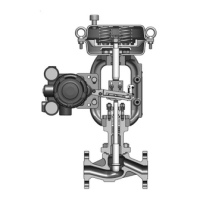4-1-2. Periodic Inspection
Disassemble the control valve once every two or three years. Replace consumables and repair
or replace any parts that have deteriorated. When disassembling the valve, be sure to observe
the instructions in “Chapter 5. Disassembly and Reassembly of the Control Valve”.
Recording inspection results
Recording the results of periodic inspection on the following items is recommended. The
records will be useful in estimating the remaining service life of the product, troubleshooting,
identifying consumables that should be replaced, and in other various circumstances.
Precautions
• Before uninstalling the control valve from the equipment, check that removal of the valve
will not affect the performance of the equipment.
• When disassembling the control valve, refer to “5-4. Disassembling the Valve Body” for
the particular model and take necessary notes for reassembly of the valve.
• Before disassembling the control valve, send dummy inputs to the actuator or the positioner
to check for any problems.
Checklist
(1) Appearance
Check the diaphragm case, waterproof cap, yoke, stem connector, bonnet, valve, bolts,
nuts, and air piping for damage or corrosion, and check that all necessary parts are
attached. In addition, check if the paint is worn out.
(2) Damage to stems
Check the valve stem and actuator stem for damage.
(3) Leakage from the valve body and bonnet connection
Check the connection between the valve and bonnet for any signs of leakage.
(4) Leakage from the gland
Check the gland for any signs of leakage.
(5) Damage to the valve plug or seat ring
Check the valve plug and seat ring seats for damage or deterioration such as corrosion
that will cause a leak from the valve seat. If a problem is found, lap, re-machine, or
replace the part.
(6) Damage to the guide caused by foreign matter
Check the guide for the valve plug and the guide in the bonnet for burrs, deformation,
and damage caused by foreign matter. If a problem is found, repair or replace the part.
(7) Scale in the valve
Check the valve, valve plug, inside surface of the bonnet, gland box, seat ring, etc., for
scaling. Remove any scale that has accumulated in the valve.
(8) Damage or corrosion on the inside of the gland box
Check the gland box for damage or deterioration, such as corrosion, which will cause a
leak from the gland. If such problem is found, re-machine or replace the part.
4-3

